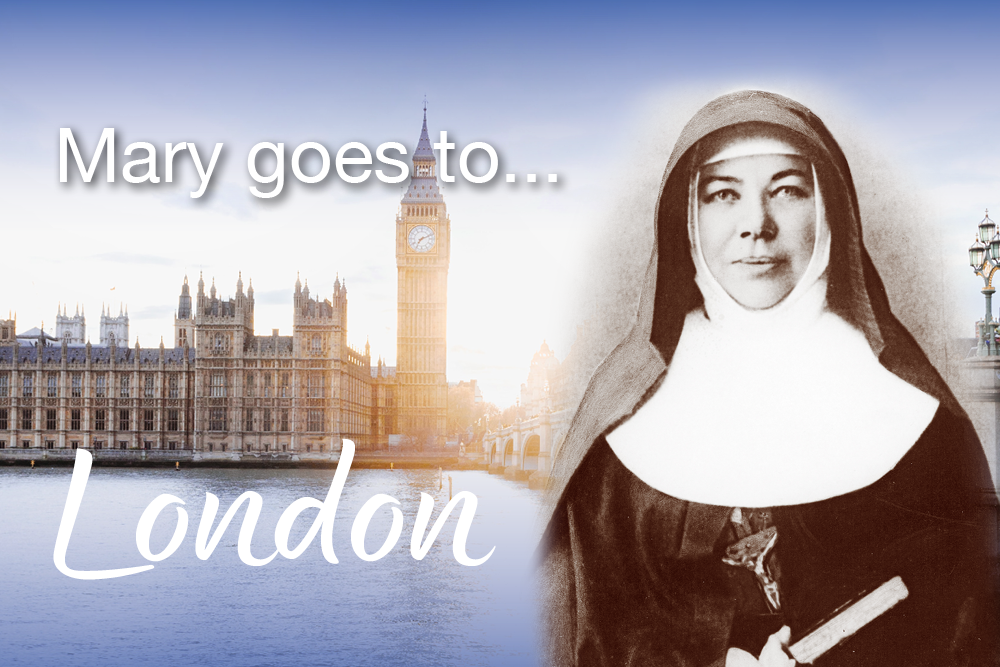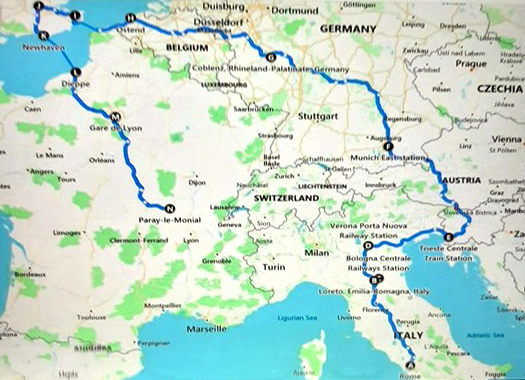
To celebrate 150 years since Mary MacKillop embarked on her first overseas journey (March 1873 – December 1874), the Sisters of Saint Joseph share reflections and details from Mary’s travels to and from Europe – sourced from Mary’s letters and Congregational Archives.
When we celebrated Easter week earlier this year, we were powerfully reminded of pain, isolation and fear all embodied in the women who went to the tomb. The Angel told them “Do not be afraid!” Their pain gave way to hope and, later, joy when they knew that Jesus had risen and visited them.
I was drawn then to read again the excerpts from Mary MacKillop’s diary from August to mid-October 1873. Mary had been in Rome to endeavour to have the Constitutions for the Sisters of Saint Joseph of the Sacred Heart approved. The revised Constitutions were eventually completed with the assistance of several priests in Rome and sent to Pope Pius IX for approval. It was expected that the process would take quite some time.
The heat of Rome had been burdensome for Mary who attributed much of her frequent illness there to humidity and heat. Her fledgling congregation was uppermost in her mind together with a deep desire to obtain materials for the schools, learn about the methodology in Germany and, perhaps, find some young women to join her. On advice, she decided to leave Rome, visit some schools and make her way to London depending on friends and the Providence of God to provide the means to do so.
On 1 August 1873, she set out on a journey that was truly formidable in that era. She left Rome by train and visited the Holy House at Loreto spending two days there. She then travelled to Bologna where she arrived at midnight, stayed in the station waiting room and left at 3:00am for Verona arriving there at 9:00am. She spent that day also in the waiting room and left at 3:30pm for Trieste where she arrived at 6:00am next day.
The Convent, where she hoped to spend the day, could not accommodate her necessitating Mary to go elsewhere. Compounding her dilemma was the fact that she did not have sufficient money to complete the journey. That afternoon a kind lady took her to Rev Baron von Obercamp from whom she borrowed the money to continue her journey. She left Munich at 6:30pm to catch the train to Coblentz where she arrived at 9:00am next morning. She remained at Coblentz for a week “with the kind sisters” visiting schools, noting teaching methods and obtaining school materials from suppliers. Satisfied with her experience there, Mary set out to make her way to Dover to connect with friends in London.
As was customary when crossing borders, there were custom checks. At the Belgian border, the train stopped at Verviers where she had her bags examined. Being alone and unfamiliar with the station, she took the wrong train and found herself in Brussels. With a feeling of helplessness from not knowing the area, she took the best option available and spent another night in a waiting room. Early next morning she took the train to Ostend from where she caught a steamer to Dover and then the train to London to join friends – friends who spoke her language and cared for her, thus alleviating her feelings of isolation.
At the invitation of Fr Christie, an Irish Jesuit, she joined a pilgrimage from London to Paray-le-Monial, the home of the shrine of the Sacred Heart. This was another journey that tested her stamina. The pilgrimage group left at 4:30am from London for Newhaven to join a crossing to France so rough that Mary wrote, “and all so sick on board”. The pilgrims reached Paris around 11:00pm. Mary “felt tired, lonely and ill, and, Oh, so thankful for a quiet rest.”
The next stage of the journey took them to Paray-le-Monial where they joined the moonlight procession that reached the shrine at midnight. At its conclusion, Mary went to the Convent of the Blessed Sacrament. A priest there, noticing that she was very ill, suggested she go to the Chapel at that late hour and receive Communion. He had realised that she was physically unable to fast until the Mass later in the morning. Next day, although feeling “very ill and tired” Mary participated in all the activities of the pilgrims and then, spent the night in the Chapel of the Apparition until it was time to leave at 4:30am for the return journey to London. On arrival back in London she had journeyed several thousand miles since she left Rome. (See the map below).
What really moved me was Mary’s frequent expressions of sadness resulting from her isolation. It was not an isolation that was imposed externally as it is today for many of us. It was an isolation born of lack of language to communicate coupled with lack of the companionship of people she knew and loved. Her isolation was exacerbated by her unfamiliarity with places, train timetables and even travelling companions.
Mary was, like the Easter women, mourning the losses visited on her congregation by events back in Adelaide. She, however, met many people who extended kindness to her. There was “the kind Italian man” who helped her at the Italian-German border and saw her to the train for Munich; the porter who carried her bags when she finally arrived in London; the priest who lent her money to enable her to continue her journey and the Sisters who were so kind to her in Coblentz and Paray-le-Monial. What struck me as poignant was that at the end of each week she wrote, “1 week from Rome” and so on each week signalling that Rome, at that moment, was the anchor that gave her a point of reference and stability.
Mary’s isolation was even more trying because, on many days, she reported how ill she was and frequently wrote, “I was so lonesome”. She responded to her isolation, not looking to her external world, but looking to the fertile ground of her inner life. Her composure and stability came from her fervent dependence on the love of her “good God”. Whenever she could, she attended Mass and received Holy Communion, a privilege not common in that era. She was almost ecstatic during her brief time in Paray-le-Monial, the place where Jesus revealed His love for the world through the image of a burning Heart. Devotion to the Sacred Heart was very dear to Mary.
As often happens to travellers, many strangers and new friends extended acts of kindness and comfort to her throughout her days of travel. There was the stranger who carried her “bag into the Custom Room at the frontier (between Italy and Germany) and assisted me in every way” (4 August).
There were numerous others who helped her when she was ill, needed accommodation or was simply lonely. Over and over, she wrote of her loneliness that was only assuaged by her visits to the Blessed Sacrament and having the comfort of her faith. She did not succumb to despair or fear.
Mary’s chosen lifestyle, her poor health, her lack of foreign languages and knowledge of the cities she travelled through, all contributed to her isolation. She found her “resurrection” from the tomb of isolation by turning inwards to the garden of her mind where she found nourishment for her relationship with God as well as encouraging resilience and audaciousness. Even while sick, lonely and seemingly lost she did not fear or panic or focus on the inane.
Mary’s message for us today is clear – to cheerfully accept the unexpected kindness of others, to reciprocate and, above all, to nurture our relationship with God, to be full of hope and joy so that, like the Easter women, we too can meet the Risen Jesus and recognise him in our neighbour.
Maria Casey rsj
Mary’s Journey from Rome to London (England) and to Paray-le-Monial (France)

A: Rome → B: Loreto → C: Bologna → D: Verona → E: Trieste → F: Munich → G: Coblenz → H: Ostend → I: Dover → J: London → K: Newhaven → L: Dieppe → M: Paris → N:Paray-le-Monial.
From Paray-le-Monial and back to London: Paris, Dieppe and Newhaven not lettered again.
